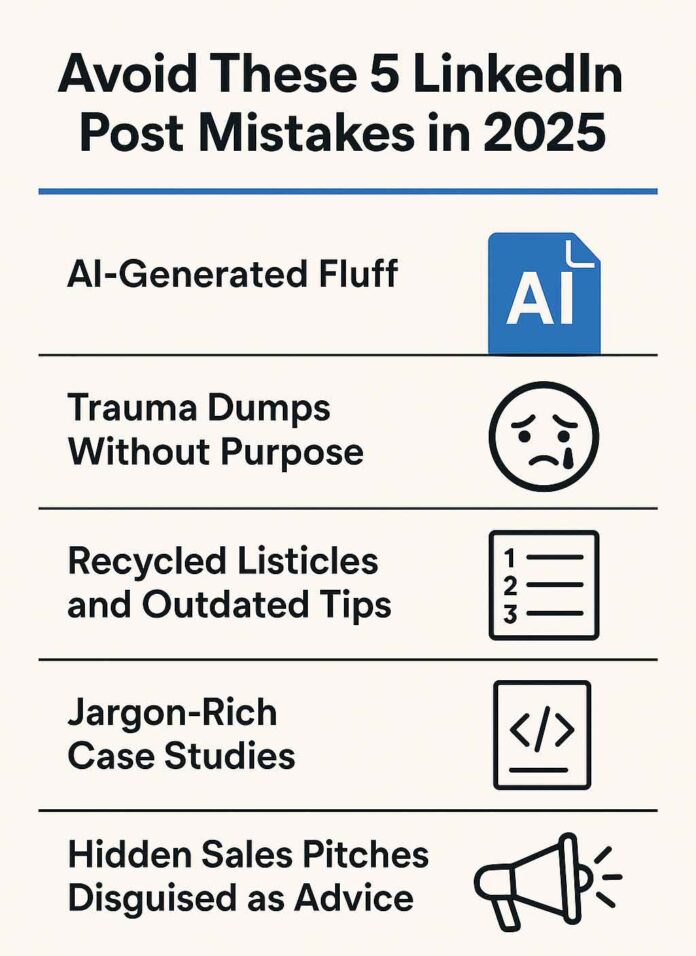In 2025, LinkedIn is not just a digital resume it’s the world’s most active professional community. Millions of professionals use it daily to connect, build their brand, and share insights. However, the platform is also overrun with posts that seem repetitive, shallow, or even off-putting.
If you’re serious about growing your influence and creating meaningful connections on LinkedIn this year, it’s imperative to know what kind of content to steer clear of. In this article, we’ll walk through five types of LinkedIn posts that no longer work in 2025 and offer better ideas to help you stand out, whether you’re in India, the U.S., or anywhere globally.
AI-Generated Fluff
With the rise of AI tools, many users are now posting content written entirely by machines. These posts often feel too polished, overly generic, and lack personal insight. They may include phrases like “Success is a journey” or “Leadership is all about mindset” but offer no real substance or personal experience.
What to Post Instead:
Add your voice. Give a brief personal anecdote, a genuine work-related lesson, or your thoughts on a trend in your industry. If you use AI tools, ensure to edit the post heavily so it sounds like you. Human touches like humour, honesty, or vulnerability will always perform better, especially on a platform built for genuine conversations.
Trauma Dumps Without Purpose
LinkedIn is not the right platform to share emotional breakdowns without context. Yes, personal stories can be powerful, but when they lack structure or a clear takeaway, they feel like attention-seeking posts rather than helpful insights.
What to Post Instead:
Vulnerability is acceptable as long as it is balanced with worth. If you’ve faced a tough time such as losing a job, failing at a startup, or dealing with burnout — try to reflect on what you learned from it. How did you evolve? What piece of advice would you give to someone experiencing the same situation? That turns your experience into something meaningful and valuable for others.
Recycled Listicles and Outdated Tips
You’ve seen them: “Top 5 Tips for Better Time Management” or “10 Habits of Successful People.” These kinds of posts were popular five years ago, but today they blend into the background noise. People scroll posts because they’ve seen the same tips repeatedly.
What to Post Instead:
Try sharing one unique lesson instead of a list. For example, “The one productivity hack I learned from my grandmother that still works today.” Make it fresh. You can still offer tips, but use storytelling, unique experiences, or new data to keep it interesting and relevant.
Jargon-Rich Case Studies
Many brands post case studies with too many technical terms or buzzwords and lack clarity. Words like ‘synergy,’ ‘scalable pipeline,’ or ‘performance-driven optimization’ may sound impressive, but they don’t explain what happened.
What to Post Instead:
Please keep it simple. In simple language, describe the problem you were addressing, your methodology, and the outcome. Use numbers where helpful, but focus on telling a narrative. For example: “We reduced customer complaints by 40% in 2 months by changing just one process.” Precise, honest results speak louder than corporate jargon.
Hidden Sales Pitches Disguised as Advice
It’s tempting to promote your product or service in every post. But if your audience feels like you’re constantly trying to sell, they’ll stop engaging. This is especially true for coaches, consultants, and startups who use educational content as a mask for promotions.
What to Post Instead:
Offer real value first. Educate your audience, solve a common problem, or share insights from your work. Then, at the end of the post, add a soft CTA (call to action). For example: “If you’re facing the same issue in your team, I’d be happy to chat.” This demonstrates your willingness to help rather than sell and fosters trust.
Why This Matters in 2025
LinkedIn’s algorithm is changing. It favours high-quality content that sparks conversations, not likes or views. That means real engagement, like comments and reposts, is becoming more crucial than ever.
At the same time, users are getting smarter. They can easily spot fake, repetitive, or viral content. If you want to grow your audience, attract the right opportunities, or build your career, focus on being honest, practical, and human in your content.
This is true if you’re targeting a specific audience, such as Indian entrepreneurs, remote workers in Southeast Asia, or tech professionals in the U.S. or the UK. No matter your niche or location, the rules of content quality are the same: Be authentic, be helpful, and be consistent.
Concluding Thoughts
LinkedIn is still a powerful platform for building your brand in 2025 but only if you use it right. Avoid content that feels fake, overused, or self-serving. Instead, share stories, lessons, and insights that reflect your journey and invite others to connect.
Whether you’re a startup founder in Bangalore, a freelancer in London, or a marketing professional in New York, the opportunity is the same: Show up with purpose. Speak with clarity post with intention.
And always remember the best content on LinkedIn isn’t about going viral. It’s about building trust.


